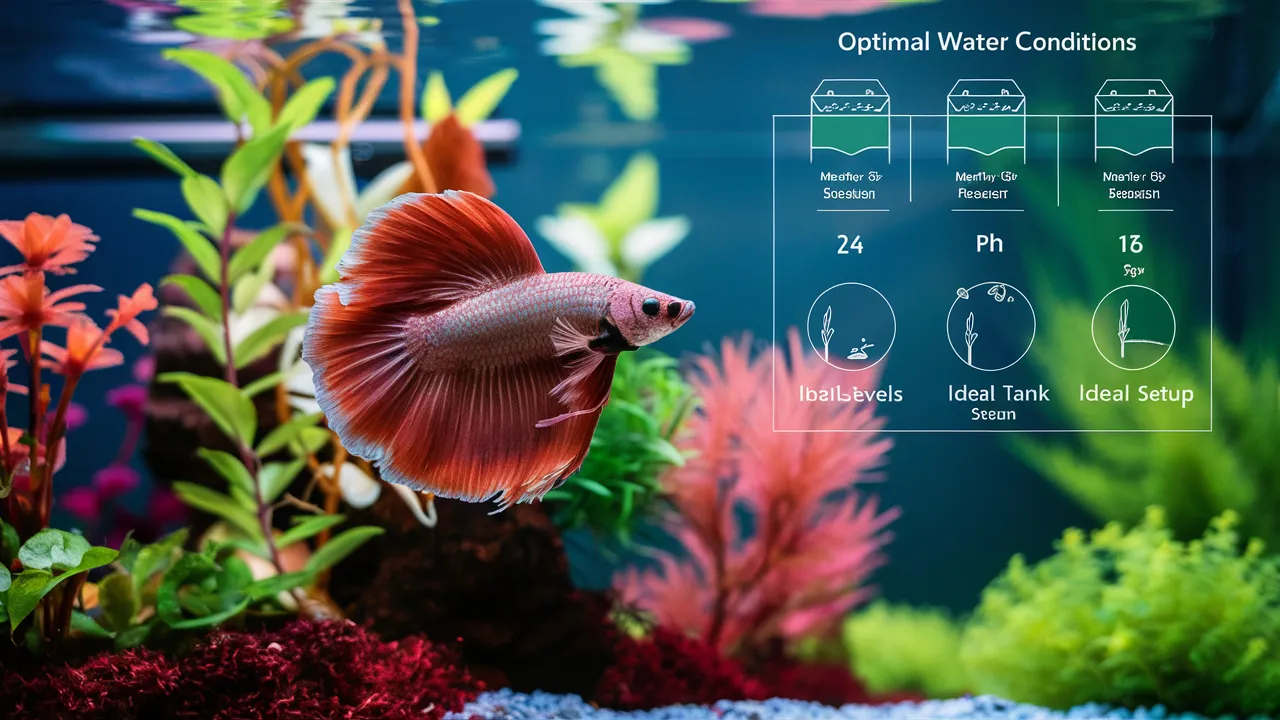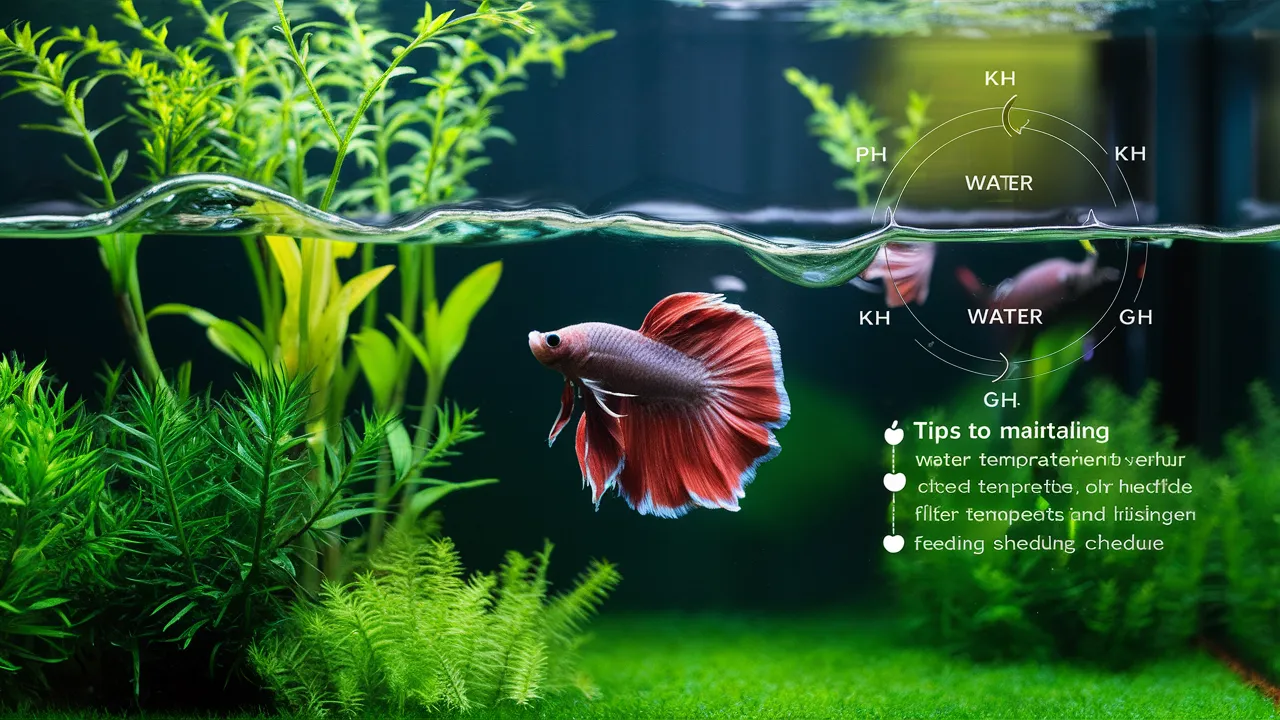Is your betta fish lethargic or showing signs of illness? Betta Fish Water issues could be the culprit. This Betta Fish Guide will explore the importance of maintaining optimal water parameters for betta fish.
Importance of water quality for betta fish
Water quality is the cornerstone of betta fish health and happiness. As any experienced aquarist will tell you, “The solution to pollution is dilution.” This adage holds especially true for betta fish, whose vibrant colors and flowing fins are directly influenced by the quality of their aquatic environment.
Proper water conditions not only ensure the physical well-being of your betta but also promote their natural behaviors and longevity.
Brief overview of natural betta fish habitat
Betta fish, also known as Siamese fighting fish, originate from the shallow, warm waters of Southeast Asia. Their natural habitats include rice paddies, slow-moving streams, and marshes. These environments are characterized by:
- Warm temperatures (75-82°F or 24-28°C)
- Slightly acidic to neutral pH (6.5-7.5)
- Low water hardness
- Dense vegetation
- Calm or slow-moving water
Understanding these natural conditions is crucial for replicating an optimal environment in your home aquarium.

Understanding Betta Fish Water Requirements
Ideal water parameters
- Temperature
Betta fish thrive in warm water, mirroring their tropical origins. The ideal temperature range is between 78-80°F (25.5-26.7°C). Consistency is key; sudden temperature fluctuations can stress your betta and compromise their immune system.
- pH levels
The optimal pH range for betta fish is slightly acidic to neutral, between 6.5 and 7.5. While bettas can tolerate a wider range, maintaining a stable pH within these parameters will help your fish thrive.
- Hardness
Betta fish prefer soft to moderately hard water. The ideal range is between 5-20 dGH (degrees of General Hardness). Extremely hard water can stress bettas and affect their overall health.
- Ammonia, nitrite, and nitrate levels
-
- Ammonia: 0 ppm (parts per million)
- Nitrite: 0 ppm
- Nitrate: <20 ppm
Any detectable levels of ammonia or nitrite can be harmful to your betta. Nitrate levels should be kept below 20 ppm through regular water changes and proper tank maintenance.
The nitrogen cycle in aquariums
The nitrogen cycle is a biological process that converts toxic ammonia (from fish waste and uneaten food) into less harmful nitrates. This cycle involves beneficial bacteria that colonize your tank’s filter and substrate.
- Ammonia → Nitrite → Nitrate
- Establishing the nitrogen cycle:
- Takes 4-6 weeks in a new tank
- Use a quality bacterial starter to speed up the process
- Monitor levels regularly during cycling
- Importance:
- Prevents ammonia and nitrite poisoning
- Creates a stable, healthy environment for your betta

Water Preparation Techniques
Dechlorinating tap water
Tap water often contains chlorine and chloramines, which are harmful to fish. To make tap water safe:
- Use a water conditioner that neutralizes both chlorine and chloramines
- Follow the product instructions for dosage
- Allow the treated water to sit for 15-20 minutes before adding it to the tank
Using water conditioners
Water conditioners do more than just dechlorinate. They can also:
- Neutralize heavy metals
- Provide a protective slime coat for your fish
- Some products help detoxify ammonia and nitrites
- Popular brands include Seachem Prime, API Stress Coat, and Tetra AquaSafe.
Aging water (pros and cons)
Aging water involves letting tap water sit for 24-48 hours before use.
Pros:
- Allows chlorine t o evaporate naturally
- Can help stabilize pH and temperature
Cons:
- Doesn’t remove chloramines or heavy metals
- Takes up space and time
- May collect dust or contaminants if left uncovered
Reverse osmosis and remineralization
Reverse osmosis (RO) water is ultra-pure but lacks essential minerals.
- Benefits of RO water:
- Removes nearly all impurities
- Allows precise control over water parameters
- Remineralization:
- Essential for adding back necessary minerals
- Use products like Seachem Equilibrium or Salty Shrimp GH/KH+
While RO water offers the most control, it’s often unnecessary for most betta keepers unless your tap water is particularly problematic.
Maintaining Water Quality
Regular water change schedule
Regular water changes are crucial for removing accumulated toxins and replenishing essential minerals. For a betta in a properly sized tank:
- Change 10-20% of the water weekly
- For smaller tanks, more frequent changes may be necessary
- Always match the temperature and parameters of the new water to the tank water
Proper cleaning techniques
Use an aquarium vacuum to clean the substrate
Rinse filter media in old tank water, not tap water
Clean algae from tank walls with an algae scraper
Avoid using soap or chemicals on any aquarium equipment
Avoiding overfeeding
Overfeeding is a common cause of water quality issues. To prevent this:
- Feed small amounts 2-3 times daily
- Only offer what your betta can consume in 2-3 minutes
- Remove any uneaten food after feeding
- Consider fasting your betta one day per week
Plant benefits for water quality
Live plants can significantly improve water quality by:
- Absorbing nitrates and other waste products
- Oxygenating the water
- Providing natural filtration
- Creating a more natural environment for your betta
Beginner-friendly plants include Java fern, Anubias, and Marimo moss balls.
Conclusion
Maintaining proper water conditions is the foundation of successful betta fish keeping. By understanding and managing the key parameters of betta fish water, you’re providing your aquatic friend with the best possible environment to thrive.

Related Posts
Culture Of Infusoria In The Tank: A Microscopic Feast for Fry
Almond Leaf For Betta: A Natural Habitat Enhancer
Clamped Fins On Betta: Causes & Treatment